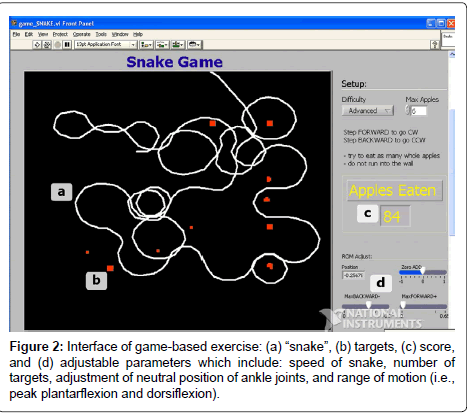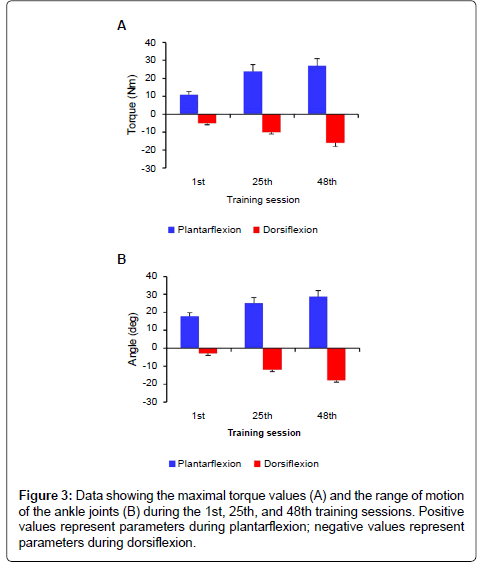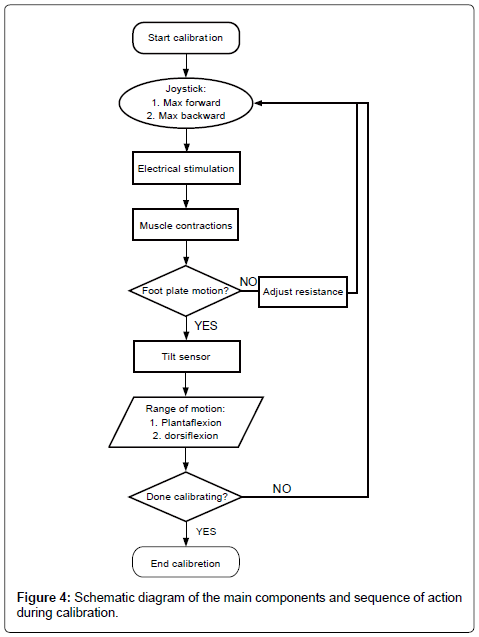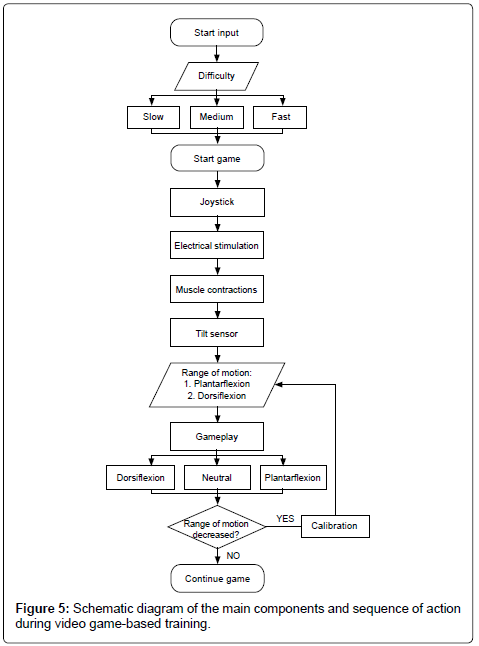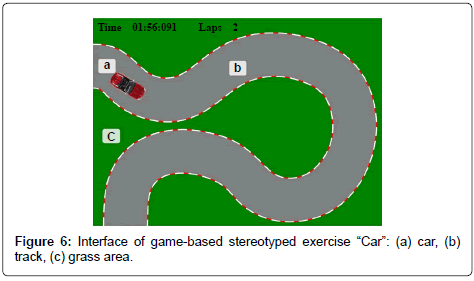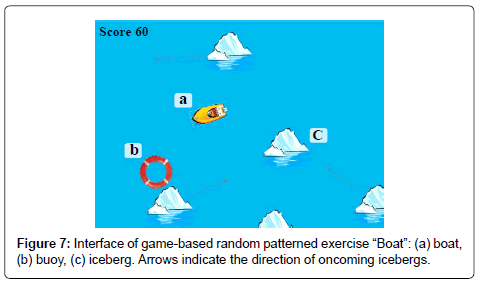Research Article Open Access
Video Game-Based Approach in Calf Muscle Training: Lessons from Pilot Study.
Dimitry G Sayenko1,2*, Mark F Robinson1, Matija Milosevic1,3, Kei Masani1 and Milos R Popovic1,31Rehabilitation Engineering Laboratory, Toronto Rehabilitation Institute, Lyndhurst Centre, 520 Sutherland Drive, Toronto, Ontario, M4G 3V9 Canada
2Department of Neurological Surgery, School of Medicine, University of Louisville, 220 Abraham Flexner Way, Ste. 1506, Louisville, Kentucky, 40202 USA
3Institute of Biomaterials and Biomedical Engineering, University of Toronto, 164 College Street, Toronto, Ontario, M5S 3G9, Canada
- *Corresponding Author:
- Dimitry G. Sayenko
Department of Neurological Surgery
School of Medicine, University of Louisville
220 Abraham Flexner Way, Ste. 1506
Louisville, Kentucky, 40202 USA
Tel: +1-502-582-7443
Fax: +1-502-582-7605
E-mail: dimitry.sayenko@jhsmh.org
Received Date: February 27, 2013; Accepted Date: June 21, 2013; Published Date: June 26, 2013
Citation: Sayenko DG, Robinson MF, Milosevic M, Masani K, Popovic MR (2013) Video Game-Based Approach in Calf Muscle Training: Lessons from Pilot Study. Clin Res Foot Ankle 1:110. doi: 10.4172/2329-910X.1000110
Copyright: © 2013 Sayenko DG, et al. This is an open-access article distributed under the terms of the Creative Commons Attribution License, which permits unrestricted use, distribution, and reproduction in any medium, provided the original author and source are credited.
Visit for more related articles at Clinical Research on Foot & Ankle
Abstract
Gaming technology is a popular application for physical rehabilitation. However, the key problem with a considerable group of patients is that their muscle function is extensively compromised, which significantly narrows the population eligible for video game-based rehabilitation. We designed a training system to integrate gaming and functional electrical stimulation for the lower leg muscles. Such a system is expected to motivate individuals to exercise more, to assist muscle control, and to promote muscle strengthening. In our previous study, we demonstrated that the training improved the lower leg muscles’ strength and increased the range of motion of the ankle joints. Here we discuss some issues associated with a video game-based approach in rehabilitation, which need to be addressed. In particular, one of the biggest challenges is in maintaining a proper balance between flexibility of the game application to allow adaptation to the patient’s needs from physiological and functional perspectives, and attractiveness of the game interface, all while assuring the most efficient and motivating rehabilitation. As the next step, we decided to design different types of game-based exercises and to expand the variety of game strategies in order to promote and maintain activity of peripheral and central structures of the neuromuscular system, and to avoid the monotony of repetitive tasks. Our ultimate goal is to transfer re-training of movement skills practiced during video game-based interventions to the ability to complete real world tasks and participate in functional activities outside of therapy.
Keywords
Muscle function; Video game-based rehabilitation; Physical rehabilitation; Rehabilitative interventions
Introduction
Home-based rehabilitation of motor function is becoming a more commonly suggested solution to the problem of insufficient inpatient care and one that may facilitate the maintenance and improvement of a patient’s physical health status [1,2]. It has been suggested that since interactive computer gaming already plays an important role in the lives of many people, video game applications may be also used to enhance motivation during rehabilitation [3,4]. A video game-based approach is considered appropriate for rehabilitation because of its well-known assets. These include the opportunity for active learning, which encourages and motivates the participant. In addition, it includes the ability to simulate behavior in a challenging but safe environment while maintaining strict experimental control over stimulus delivery and measurement [2]. Moreover, video game-based approach can be implemented when the course of conventional therapy is completed, thus encouraging patients to further improve function. For instance, it has been demonstrated that individuals with chronic incomplete spinal cord injury (SCI) can improve their upright static and dynamic postural control following video game-based balance training [5]. Several studies have reported that participants experienced high levels of enjoyment while playing video games developed for rehabilitation [6,7] and achieved a high number of repetitions [2,8], which are critically important for successful rehabilitation. This may lead to greater motivation to exercise more between sessions or at home [6]. Because of the low cost and technical simplicity, the video game-based approach could be used to sustain a person’s continued level of activity in his or her own home after being discharged from rehabilitation. As such, video game-based therapy may be a way to supplement routine rehabilitative interventions.
Despite the benefits of game-based rehabilitation, one of the main problems is that the games are often too difficult for individuals whose motor function is greatly compromised, thus the population eligible for training seems to be considerably reduced. Novel interventions which integrate robotic-assisted devices and gaming technology were implemented recently in rehabilitation after stroke [9]. Although, the effectiveness and feasibility of this approach in different patient populations is yet to be explored, the high cost of these devises, their portability, as well as the requirement for active therapist involvement, limit their wide application in neuromuscular rehabilitation. As such, there is a compelling motivation to address the needs of individuals with disabilities by promoting low-cost, portable, and easy to control and operate system, which will engage and motivate individuals to participate in game-driven physical activities and rehabilitation programs.
As one of the pioneers in this field, we suggest that this task can be unraveled by means of functional electrical stimulation (FES)- assisted contractions [10]. FES uses sequences of short electric pulses to generate muscle contraction [11,12]. By stimulating a specific set of muscles and employing specific stimulation sequences FES can generate movements in individuals with impaired neuromuscular function, or even with paralysis. To date, FES systems have been used extensively as assistive devices, which patients could use in order to perform specific motor tasks such as standing [13], walking [14], and grasping [15]. In addition, FES is known as a countermeasure to musculoskeletal atrophy which is associated with many neuromuscular disorders [16]. Finally, it has been demonstrated that goal-oriented exercises coupled with electrical stimulation may promote adaptive plasticity of the central nervous system, and result in greater functional outcomes as well as clinical/physiological improvements [17].
Based on these considerations, we proposed a video game-based training system that is designed to combine and augment the advantages of both rehabilitation techniques. Consequently, by combining two key technologies, namely video gaming and FES, we believe that we can provide a training method that will motivate individuals with impaired motor function to exercise more during clinically based rehabilitation or at home, to assist in performing motor tasks, and to promote muscle strengthening. To the best of our knowledge, the efficacy and feasibility of combined FES and video game-based rehabilitation have not been investigated yet.
Previous Study
In our recent pilot study [10], conducted with a participant who had chronic complete SCI, we tested the feasibility of the video game-based FES training system and its efficacy with respect to the strength and endurance of the lower leg muscles, as well as to the range of motion (ROM) of the ankle joints. The participant was actively involved in the training procedure by operating the video game controls via FES-induced ankle joint motions. The participant adjusted the level of electrical stimulation delivered to his plantarflexors or dorsiflexors using a joystick, which was connected to a Compex Motion programmable 4-channel neuromuscular electrical stimulator (Compex SA, Switzerland) [11,12]. The applied electrical stimulation evoked corresponding muscle contractions that resulted in changes in ankle joint angular displacement. This ankle joint angle was used as the control input for the video game. Real-time data acquisition, processing, visualization, and storage were performed using the LabVIEW 8.5 software package (National Instruments, USA).
During the training, the participant was seated on a padded bench with a backrest support, and the feet were firmly strapped to the foot platform (Figure 1). The platform was attached to the main shaft of the training device, which was inserted in the side bearings allowing for smooth rotation. The axis of rotation of the main shaft was aligned with that of the ankle joints. The main shaft was composed of two sections, one of which supported the footplate, and the other which held the inverted pendulum. The inverted pendulum was 1m in length and was held in the upright position by the notch in the main shaft. The system allowed the participant to perform isotonic and isometric plantarflexions and dorsiflexions against exterior resistance provided by the inverted pendulum and weight.
The goal of our game was to navigate a moving “snake” around the screen in an attempt to hit as many randomly appearing targets as possible without colliding with the wall (Figure 2). The turning radius of the “snake” was controlled by the position of the ankle joints detected by the tilt sensor (Kionix KXM52- 1050, Kionix Inc. Ithaca, NY, USA). Although only one type of ankle joint motion was used (i.e., plantarflexion and dorsiflexion), resulting in only one rotational degree of freedom, the multidirectional displacement of the “snake” was controlled utilizing three types of motion: with the joints in neutral position, the “snake” moved in a straight line; in order to produce clockwise or counterclockwise turns of the “snake”, the participant had to elicit plantarflexions (forward inclination of joystick) or dorsiflexions (backward inclination of joystick), respectively. Visual feedback was provided by a large LCD monitor placed at eye level about 1.5 m in front of the participant. To motivate the participant to improve his performance, a score representing the number of collected targets was displayed. The game parameters were adjustable, namely, the speed of the snake and the number of targets, as well as the neutral position in the ankle joints and the sensitivity of the tilt sensor to the angular displacement of the foot platform. The size of the snake increased as the participant progressed in the game, thus making navigation more difficult, although in this version of the game colliding with the body of the “snake” does not cause the player to lose. The training was performed 3 days per week for a total of 48 sessions. Each session lasted up to 60 minutes with a total FES time of at least 45 minutes. The overall torque representing resultant torque exerted by the stimulated muscles and passive torque produced by the training device, as well as the angular displacement of the foot platform (corresponding to ankle joint position) were recorded during the 1st, 25th, and 48th training sessions. In addition, an open-question interview was carried out to assess motivational aspects of the training and to capture the participant’s opinion on how the training system could be improved [1,7,18].
We demonstrated the feasibility of our system in an individual with motor complete paraplegia. The system provided a progressive overload for the trained muscles, which is a prerequisite for successful muscle training. The training resulted in a significant improvement of the strength and endurance of the paralyzed lower leg muscles:
- During the 1st training session, the maximal torque values reached 11.0 ± 1.7 Nm and -5.1 ± 0.8 Nm during plantarflexion and dorsiflexion, respectively. Whereas during the 48th session, the torque values increased up to 27.0 ± 4.0 Nm and -16.0 ± 2.0 Nm during plantarflexion and dorsiflexion, respectively (Figure 3A).
- The range of motion of the ankle joints also increased from 17.7 ± 2.1° and -2.9 ± 0.8° (1st session) to 28.7 ± 3.4° and -17.9 ± 1.5° (48th session) during plantarflexion and dorsiflexion, respectively (Figure 3B).
Another key observation was that the interactive gaming FES intervention can motivate a person with chronic SCI to perform muscle training exercises. The game score representing the overall number of collected targets during the 1st session reached 12 points, and increased throughout the training period, reaching 421 points by the 48th session. Moreover, during the interview, the participant reported that he enjoyed controlling the video game-based training. He stated that the video game was challenging to play, but could be easily adjusted to meet the needs of the participant. The participant also reported that the instruction to maximize his score during each trial motivated him to play and to keep his attention on the game throughout the whole session. The participant was encouraged to participate in this training program on a regular basis.
Considerations from Previous Study
We have demonstrated that video game-based FES training resulted in improvement in the lower leg muscle strength and endurance for one participant, as well as in the range of motion of the ankle joints. We also documented that our participant enjoyed the training process. However, despite the benefits of our training, we discovered a number of issues associated with video game-based rehabilitation, which need to be addressed. First, the entertainment component of the system should be tied to the exercise challenge and guide the user through the protocol to minimize the need for therapist intervention. Secondly, the system must be easily customizable to meet each patient’s need and condition. Thirdly, the games for rehabilitation have to be as enjoyable as possible. Video games are not “intrinsically” fun, and playing a poorly designed or monotonous game for an hour will not necessarily be more engaging than other forms of training.
Given the emphasis in our first game application on repetitive tasks and adjustable parameters, our game interface in terms of its design and presentation was not as appealing as that of commercially-available games. Therefore, although our participant indicated that he enjoyed the video game-based tool, and that he would like to continue the treatment, there is still a need to improve the game interface, and make it suitable and engaging for other users of different age or gender.
Given the variety of existing commercially available games and gaming platforms, it seems very logical and attractive to implement them in clinical population. Unfortunately, commercially available games, although often having very appealing user interfaces, are currently not suitable for rehabilitation purposes [19-22]. Their non-rehabilitative focus leads to a number of issues: games mainly target upper-body gross motor functions, games lack support for task customization, grading, and proper quantitative measures of performance, and gameplay is typically complex, requiring multiple degrees of freedom and multi-button controls. It is possible that the addition of more controls not directly linked to a rehabilitative action would lessen the amount of muscle exercise the patient receives in a training session of a given length. This trade-off between enjoyment of the game and therapeutic benefits must be carefully weighed when designing both hardware and software for rehabilitation. Additionally, the lack of feedback to users or medical supervisors on the functional improvements of patients throughout their training limits the ultimate conclusions that could be drawn following long-term studies. Besides, ensuring that proper training principles are followed generally requires the continuous participation and supervision of skilled medical or technical staff. Furthermore, some games require the user to have a base level of reaction time and input dexterity to play in the way the game designers intended. In addition, progression through the storyline of a game might not require any long term improvement above that initial level of skill. Many patients using games for rehabilitative purposes would not have such ability at the outset of the training, and focusing on those goals can even sometimes be harmful to the therapeutic patient outcomes. Parameters such as range of motion, motor control, strength, and endurance, which are prerequisites for successful rehabilitation, are not systematically targeted.
Further, when combining FES with video-gaming, one should take into consideration that the electrically stimulated contraction of large muscles such as those in the lower legs introduces a large input delay to the game control and feedback system on the order of 500 ms. Games requiring quick fine adjustment of some parameter do not lend themselves well to this kind of control and can be very frustrating to play. We suggest that games that require long deliberate input action are better suited as rehabilitation games. One example might be a flying game with insensitive or “high inertia” turning controls.
As the next step, we determined to design different types of video game-based exercises with the goal to encourage participants to use multiple repetitions of purposeful movements, and to avoid monotony of repetitive tasks and complement the software interface with functions that allow for monitoring and recording of training sessions. Finally, algorithms for calibration and automatic on-line modification of the game parameters according to participant’s performance will be developed and added to the training protocol.
Future Development
Calibration
During calibration, the sensitivity of the system, resistance, range of motion, and the intensity level of FES, will be adapted to the participant’s capabilities (Figure 4). The participant will be instructed to perform FES driven non-isometric concentric plantarflexion and dorsiflexion by moving the joystick fully forward and fully backward. The resistance will be adjusted to ensure the sufficient range of motion of the footplate to control the game. If the participant is not be able to move the footplate successfully, the resistance will be decreased by either the participant or the therapist, and/or the stimulation intensity of FES will be automatically increased should the participant choose this option. The calibration will be performed separately for plantarflexion and dorsiflexion. The established range of motion will be further used to ensure that the participant is able to manipulate objects or interact with the game environment and its objects within the limits of the screen.
Training
Video game-based exercises will be designed to encourage participants to perform multiple repetitions of purposeful movements (plantarflexions and dorsiflexions). The games may vary but the principles of the gameplay will remain common (Figure 5). First, the difficulty level (e.g., speed, number of targets) will be selected. An interface will be used so that the continuous real-time position of the ankle joint will be expressed in the form of different moving objects (e.g., “car”, boat etc.) that are displayed on a large digital screen placed in front of the participant. The multidirectional displacements of the objects, triggered by plantarflexion and dorsiflexion, will control the goal-directed video games utilizing three types of motion: with the joints in neutral position, the objects will move in a straight line; in order to produce clockwise or counterclockwise turns of the objects, the participant will have to elicit plantarflexions or dorsiflexions, respectively. In case if muscle fatigue will occur, which will be evidenced by a decrease of the range of motion of the footplate, the participant will be prompted to repeat the calibration procedure as detailed above.
It has been demonstrated that different brain structures are involved during either feed forward or feedback game-based training [23]. For instance, the motor cortex might be involved in feedback control whereas the cerebellum might play a role in feed forward control by acquiring internal models in new movement tasks [24,25]. One of our goals is to promote and maintain activity of those structures during the training. That will be especially in need in case of translating our gamebased training into other clinical populations, such as incomplete SCI, stroke, etc. Finally, different types of exercises will be used with the goal to expend a variety of movement strategies, and to avoid the monotony of repetitive tasks.
Stereotyped exercise (“Car”)
A given pre-planned target-directed pattern of movement will have to be generated. For instance, the participant will be instructed to navigate a “car” around a predetermined track in the shortest time possible (Figure 6). If the “car” leaves the track (moving from the gray “pavement” on to the green “grass” area), the turning speed and forward speed of the “car” will be greatly reduced, which will increase the total time to navigate the track. The curvature of the track will stay the same throughout the training period. As a participant gains familiarity with the exercise, they will begin to approach the minimum time per lap, which will require them to perform a series of high precision movements.
A therapist through the training protocol as a training plan can set the intensity and duration of the exercise, and then that can be translated into a track shape in the game since the car’s turning radius is fixed. For instance, 1s of dorsiflexion or plantarflexion might be a 45° on the track. So, if the therapist intends to provide the FES protocol as a sequence of 5s of plantarflexion, 3s of dorsiflexion, 2s pause, 5s of dorsiflexion, etc., the track then will look like 225° right turn, 135° left turn, 2s straight line, 225° right turn, etc.
In order to increase the value of the exercise, the participant will make additional laps around the track.
Random patterned exercise (“Boat”)
The participants will need to apply a general strategy of control that includes attention, decision-making, and performance of the task using different movement patterns. For instance, the participant will have a task of navigating a “boat” to a life preserver, while simultaneously having to avoid oncoming icebergs moving in random directions and at different speeds around the play area (Figure 7). Each time the buoy is captured, it disappears and then re-appears in a random location in the play area. As well, each time the participant captures 10 buoys, they advance a level and an additional iceberg is added. However, whenever the “boat” collides with the iceberg, the game score is reduced by one. Hence, the level of the game will increase automatically with participant proficiency. The long term goal of the game for each participant is to reach a level higher than ever before.
It is preferable to have a larger variety of entertaining video games targeted to different populations (i.e., dependent on disorder, age, and/ or interest). Moreover, it seems attractive to develop video games that emphasize performance of legs (e.g., skiing or roller skating), such that participants can “employ” the information from both cortical and muscle memory to enhance the effects of motor training.
Conclusion
We believe that there is much room for improvement for the technology and that game-based rehabilitation has tremendous prospects for a wide variety of patients and the senior population. Current neurorehabilitation approaches such as FES and video gamebased training suggest tremendous prospects for rehabilitation of individuals with neuromuscular and orthopedic disorders. They could lessen musculoskeletal atrophy, as well as promote functional recovery, and enhance compliance to routine exercise programs. Prior to our work, however, the aforementioned approaches were typically applied separately. By coupling FES with a video game we intend to combine and augment the advantages of both rehabilitation techniques. In the future, we propose to collaborate with game developers to design different types of rehab oriented video game-based exercises with the goal of making them as enjoyable and appealing as possible. We believe that in this day and age, it is time to create the whole niche for rehabilitation games which can be used by millions of needed users.
Acknowledgements
This project was supported by The Fellowship Program of Canadian Paraplegic Association of Ontario, and Toronto Rehabilitation Institute, which receives funding under the Provincial Rehabilitation Research Program from the Ministry of Health and Long-Term Care in Ontario.
References
- O'Connor TJ, Cooper RA, Fitzgerald SG, Dvorznak MJ, Boninger ML, et al. (2000) Evaluation of a manual wheelchair interface to computer games. Neurorehabil Neural Repair 14: 21-31.
- Rand D, Kizony R, Weiss PT (2008) The Sony PlayStation II EyeToy: low-cost virtual reality for use in rehabilitation. J Neurol Phys Ther 32: 155-163.
- Kizony R, Katz N, Weiss PL (2003) Adapting an immersive virtual reality system for rehabilitation. Journal of Visualization and Computer Animation 14:261-268.
- Riva G, Mantovani F, Gaggioli A (2004) Presence and rehabilitation: toward second-generation virtual reality applications in neuropsychology. J Neuroeng Rehabil 1: 9.
- Sayenko DG, Alekhina MI, Masani K, Vette AH, Obata H, et al. (2010) Positive effect of balance training with visual feedback on standing balance abilities in people with incomplete spinal cord injury. Spinal Cord 48: 886-893.
- Kowalczewski J, Gritsenko V, Ashworth N, Ellaway P, Prochazka A (2007) Upper-extremity functional electric stimulation-assisted exercises on a workstation in the subacute phase of stroke recovery. Arch Phys Med Rehabil 88: 833-839.
- Kizony R, Raz L, Katz N, Weingarden H, Weiss PL (2005) Video-capture virtual reality system for patients with paraplegic spinal cord injury. J Rehabil Res Dev 42: 595-608.
- Deutsch JE, Merians AS, Adamovich S, Poizner H, Burdea GC (2004) Development and application of virtual reality technology to improve hand use and gait of individuals post-stroke. Restor Neurol Neurosci 22: 371-386.
- Kwakkel G, Kollen BJ, Krebs HI (2008) Effects of robot-assisted therapy on upper limb recovery after stroke: a systematic review. Neurorehabil Neural Repair 22: 111-121.
- Sayenko DG, Masani K, Milosevic M, Robinson MF, Vette AH, et al. (2011) Video game-based neuromuscular electrical stimulation system for calf muscle training: a case study. Med Eng Phys 33: 249-255.
- Popovic MR, Keller T (2005) Modular transcutaneous functional electrical stimulation system. Med Eng Phys 27: 81-92.
- Popovic MR (2006) Transcutaneous electrical stimulation technology for functional electrical therapy applications. Conf Proc IEEE Eng Med Biol Soc 1: 2142-2145.
- Vette AH, Masani K, Popovic MR (2007) Implementation of a physiologically identified PD feedback controller for regulating the active ankle torque during quiet stance. IEEE Trans Neural Syst Rehabil Eng 15: 235-243.
- Thrasher TA, Flett HM, Popovic MR (2006) Gait training regimen for incomplete spinal cord injury using functional electrical stimulation. Spinal Cord 44: 357-361.
- Popovic MR, Kapadia N, Zivanovic V, Furlan JC, Craven BC, et al. (2011) Functional electrical stimulation therapy of voluntary grasping versus only conventional rehabilitation for patients with subacute incomplete tetraplegia: a randomized clinical trial. Neurorehabil Neural Repair 25: 433-442.
- Shields RK, Dudley-Javoroski S (2007) Musculoskeletal adaptations in chronic spinal cord injury: effects of long-term soleus electrical stimulation training. Neurorehabil Neural Repair 21: 169-179.
- Behrman AL, Bowden MG, Nair PM (2006) Neuroplasticity after spinal cord injury and training: an emerging paradigm shift in rehabilitation and walking recovery. Phys Ther 86: 1406-1425.
- Betker AL, Szturm T, Moussavi ZK, Nett C (2006) Video game-based exercises for balance rehabilitation: a single-subject design. Arch Phys Med Rehabil 87: 1141-1149.
- Anderson F, Annett M, Bischof WF (2010) Lean on Wii: physical rehabilitation with virtual reality Wii peripherals. Stud Health Technol Inform 154: 229-234.
- Burdea GC (2003) Virtual rehabilitation--benefits and challenges. Methods Inf Med 42: 519-523.
- Crosbie JH, Lennon S, Basford JR, McDonough SM (2007) Virtual reality in stroke rehabilitation: still more virtual than real. Disabil Rehabil 29: 1139-1146.
- Keshner EA (2004) Virtual reality and physical rehabilitation: a new toy or a new research and rehabilitation tool? J Neuroeng Rehabil 1: 8.
- Ioffe ME, Chernikova LA, Ustinova KI (2007) Role of cerebellum in learning postural tasks. Cerebellum 6: 87-94.
- Ioffe ME, Ustinova KI, Chernikova LA, Luk'yanova YA, Ivanova-Smolenskaya IA, et al. (2004) Characteristics of learning voluntary control of posture in lesions of the pyramidal and nigrostriatal systems. Neurosci Behav Physiol 34: 543-549.
- Ioffe ME, Ustinova KI, Chernikova LA, Kulikov MA (2006) Supervised learning of postural tasks in patients with poststroke hemiparesis, Parkinson's disease or cerebellar ataxia. Exp Brain Res 168: 384-394.
Relevant Topics
Recommended Journals
Article Tools
Article Usage
- Total views: 16198
- [From(publication date):
July-2013 - Aug 16, 2025] - Breakdown by view type
- HTML page views : 11489
- PDF downloads : 4709


